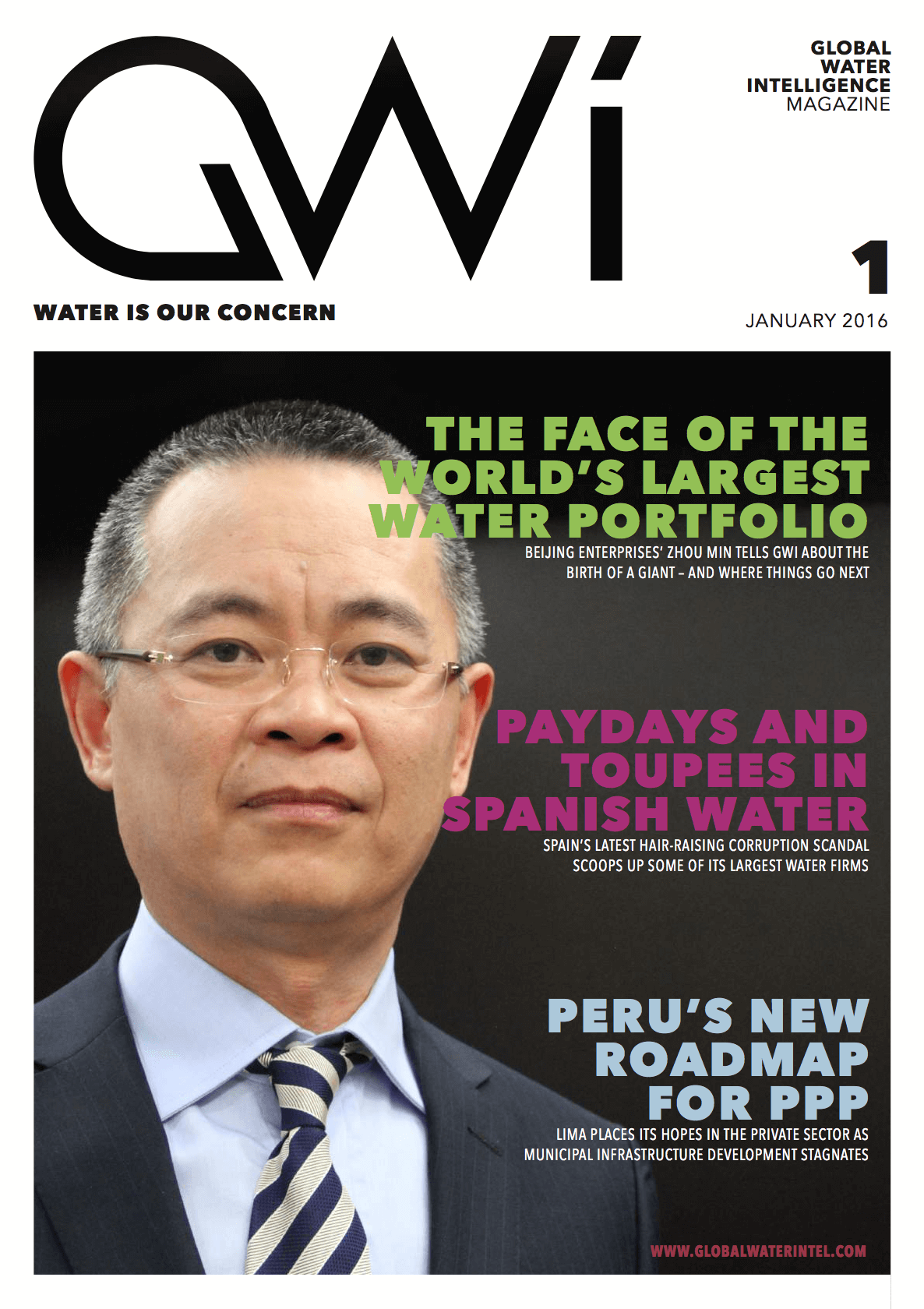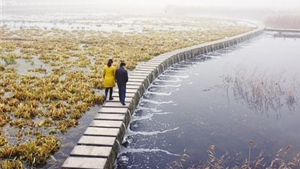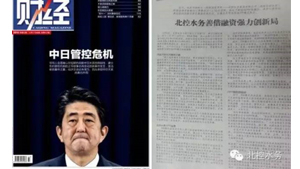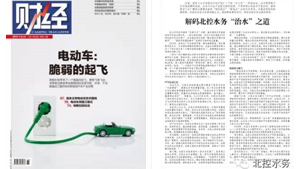GWI | THE FACE OF THE WORLD’S LARGEST WATER PORTFOLIO 2016-01-01

M&A in China and wastewater reuse upgrades are key to Beijing Enterprises’ strategy to reach its 2018 targets. Facing overseas project setbacks, the company has opted to be aggressive at home and conservative abroad. COO Zhou Min spoke to GWI’s Yujia Shen.
International commercial banks are queueing up to help state-owned developer Beijing Enterprises Water Group
(BEWG) fund its formidable project acqui- sition strategy in China. The international business, however, is proving more prob- lematic, as the company struggles to man- age risk in emerging markets.
On 18 December, the International Finance Corporation (IFC) entered into a $300 million long-term loan package with BEWG, comprising a $28 million A-loan from its own account, $21 million from its Managed Co-Lending Portfolio Program, and a $251 million B-loan from 13 com- mercial financial institutions. Eight of the banks – including global heavyweights such as BNP Paribas and the State Bank of India – had previously contributed to an oversubscribed $288 million B-loan for BEWG co-ordinated by the Asian Develop- ment Bank (ADB) in 2014.
Chinese water companies are emerg- ing as the clear beneficiaries of a perceived dearth of investable project developers else- where in Asia. “During 2015, IFC commit- ted over US$500 million to the Chinese water sector” the IFC’s Hyun-Chan Cho, head of infrastructure, Asia, told GWI.
Zhou Min, COO of BEWG and co- founder of ZKC Environmental, the com- pany which Beijing Enterprises acquired in 2008 in order to enter the water sector, is the second-largest individual shareholder in the $6.1 billion company. He met with GWI in Hong Kong to discuss the latest strategy. “This loan will be used for our major busi- ness sector: acquiring or investing in BOT/ TOT projects across China,” Zhou told GWI. “It could be used for water, wastewa- ter or reuse projects, while ADB’s loan was assigned specifically for reuse projects.”
According to Zhou, BEWG secured more than 5 million m3/d of new treat- ment capacity in 2015, including 1.2 mil- lion m3/d which is due to be injected by its parent company Beijing Enterprises Hold- ings, following the acquisition of a major- ity stake in Golden State Environmental. BEWG’s contracted treatment capacity is now just under 26 million m3/d, giving it a 6% share of the national market, ahead of second-placed rival Beijing Capital. “With the government’s beneficial policies such as the water pollution action plan, we are confident that we can meet our five-year target [of 40 million m3/d] by [the end of] 2018,” Zhou said. “The newly added capac- ity could lead to a net profit increase of 30-40% in 2016.”
While the banks appear to share Zhou’s optimism, more sceptical observ- ers have become increasingly vocal in recent months. In mid-December, the Wall Street Journal reported that “accounting leeway” at BEWG has allowed the com- pany to “front-load profits” from its BOT projects and optimistically estimate the gross margin on its construction revenues. The article warned that a saturated project market means that future growth depends on M&A of operating assets, for which the same levels of profit cannot be booked.
A detailed response from BEWG in defence of its accounting method came quickly, but it was unable to prevent a short-selling report by GMT Research in early January alleging that the company had grossly exaggerated its net profit. BEWG subsequently issued another rebut- tal, but was forced to begin buying back shares to try to stabilise the falling share price. By 19 January, the company and its directors had repurchased almost 11 mil- lion shares in the open market.
“Instead of worrying about a high con- struction margin, we would be concerned whether BEWG could have enough new BOT projects to kick-start 2016-17,” said BOCOM International analyst Wallace Cheng. “Our understanding is that BEWG’s auditor has approved the current approach of accounting for concession projects under HK-IFRIC 12. Also, BEWG has hired an independent third party to evaluate the con- struction margin for accounting.”
The level of wastewater treatment in urban areas reached 90% at the end of 2014, according to the Ministry of Envi- ronmental Protection (MEP). Neverthe- less, new projects are still emerging in suburban areas and rural towns, and high growth is expected in the market for waste- water reuse and sludge treatment upgrades. “At least 60% of the projects are in the hands of small players or local govern- ments, which will be released in the next few years,” Gu Feng, an analyst with SWS Research, told GWI. “The competition will be fierce, even though as an SOE, BEWG has the advantage during negotiations with local governments. BEWG has lowered its overall targeted IRR of new projects to 9% from the previous target of 10+%.” Meanwhile, BEWG faces a slowdown in its global ambitions. Last year it announced that it would spend S$2.0 billion (US$1.6 billion) on international expansion by the end of 2018, hoping to source 20% of its revenues from overseas.
However, in the six months ending June 2015, just 3% of its revenues came from abroad. BEWG’s glob- al plans are now decidedly less ambitious. BEWG “will take it slow in the internation- al market. We are targeting two to three water projects every year,” Zhou told GWI. “The build-up of an international team and foreign market regulations are our concerns.” In April 2014, BEWG announced that it had secured a water treatment BOT project in Medan, Indonesia, but, as GWI reported last month, CITIC Envirotech announced a remarkably similar project in November. Zhou confirmed to GWI that BEWG sold its Indonesian project to CITIC after it found itself unable to manage the risks. “The Indonesian market used to be in our plan, and we had signed contracts already. However, the progress of the pro- jects was very slow,” he said. “In the end, we think that the market is a bit risky; we lack knowledge of the market and their law, so we sold it.” Despite being pre-qualified, BEWG also pulled out of the Umbulan Spring tender in Indonesia last month.
While it focuses purely on BOT projects at home, BEWG has opted for EPC work as a route into Malaysia. “The Malaysian mar- ket will be our focus [overseas],” Zhou said. “We had one water project in Malaysia [in 2015] and are planning one to two projects [in 2016]. “As for Singapore,” he said, “suc- cessful operation of the existing project [the Changi II NEWater Plant] will be our priority. We will target more projects in the future once our international team is built.”
BEWG may have more luck leveraging its political connections to secure projects. The official establishment of the Asian Infrastructure Investment Bank (AIIB) this month means that serious project nego- tiations can now get underway. The bank will focus on overseas projects in the ini- tial period, distributing between $10 and $15 billion per year, and will be operational from Q2 2016. BEWG has opened dia- logue with the AIIB, hoping to find a more secure vehicle for project expansion abroad.
Investment abroad may also take the form of a technology acquisition. To ben- efit from the 2015 Water Pollution Action Plan’s emphasis on upgrading wastewater treatment facilities, developers are com-peting for both domestic and foreign tech- nologies. On 11 January, BEWG teamed up with peer Beijing Capital to invest in domestic membrane technology special- ist Zhejiang Creation Environmental Pro- tection Technology – the groups will take 21% and 19% stakes, respectively. Zhejiang Creation is gearing up to list on a Beijing- based over-the-counter (OTC) market for small stocks. A Beijing Drainage Group- controlled fund, meanwhile, bought Swed- ish dissolved air f lotation specialist Purac AB in December. <










